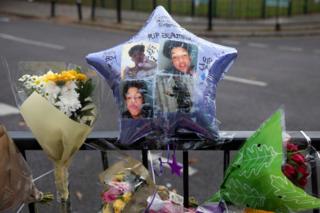 Image copyright
Getty Images
Image copyright
Getty Images
The Mayor of London used a BBC Radio 4 interview to highlight young people and knife crime. What is the true situation?
In March 2007, following a wave of fatal stabbings of teenage boys and young men in London and Manchester, the government announced that knife crime would be officially recorded in England and Wales in a way it had never been done before.
Since then, we have been able to chart the trends and set them in context.
Until around 2014, knife crime, as with overall violence, appeared to be on the decline - that's certainly what figures from the police, Ministry of Justice and health service suggested.
Since then police forces have been logging more violent offences. Some of that is due to better recording methods - but among the most serious types of violence there has been a genuine increase.
Worryingly, the involvement of young people in knife crime seems to be growing, confirming anecdotal evidence that more boys (and girls) are carrying weapons, being drawn into gangs and exploited by drug dealers.
Ten-to-17-year-olds represent roughly 20% of those cautioned or convicted of knife offences - that's possession of a knife or threatening someone with one.
Most in that age group caught with a knife receive a community sentence or warning. One in eight is sentenced to a spell in youth custody.
The bigger picture
The Office for National Statistics is responsible for the Crime Survey of England and Wales, which estimates crime trends from a sample of 34,000 people aged between 16 and 64.
The advantage of the survey is that it captures incidents that aren't reported to police, as well as those that are.
In a more recent development, the survey has begun interviewing about 3,000 10-15-year-olds to pick up crime trends among children.
The results indicate that the majority of violent incidents involving children aged 10-15 occur around schools, in daylight - and 81% lead to injury. Around 8% resulted in serious injury.
Police are alerted in only a minority of cases.
The survey also asked children whether they had carried a knife in the past year: 0.7% said they had, a figure which has remained stable over time.
Knives and schools
Legislation banning people from carrying knives without good reason dates back 65 years. The maximum sentence is a four-year jail term.
Over the decades the law has been extended and penalties toughened. In 1988 it was made a specific offence to possess a knife in school.
Staff do not need consent to search a pupil for a knife, but guidance recommends that there are two teachers present and that children are not asked to remove clothes, except items such as coats.
Further measures are currently being considered by Parliament, including widening the knife ban to further education colleges.
There's some evidence that more children are taking in knives.
A Freedom of Information request last year, to which 32 police forces responded, showed a 20% increase on the previous year in knives found in schools.
The Department for Education has compiled information about those who have been caught.
It showed that 10-18-year-olds convicted of knife-possession offences were generally lower achievers - 91.1% of them achieved one or more GCSEs, compared with 99.7% for the population as a whole - and they were also more likely than their peers to have been excluded from school.
Increasing security
There are clear benefits of having police officers permanently stationed in secondary schools, where they can pick up intelligence, help defuse tensions and win the trust of students. Not every school would want or need one, of course, but some do.
However, in London, there are only 305 Safer School Officers in a city with 3,155 schools. The Met aims to increase this to 600 by the end of March 2019.
The Mayor's office has also encouraged every state-funded secondary school to take up their offer for a knife-detecting "hand wand" - 200 schools have done so.
Youth Offending
The rise in knife crime and the apparent growing involvement of young people must be seen in the context of a substantial drop over the past decade in the number of 10-17-year-olds being arrested, prosecuted, convicted and detained for all types of crime.
That partly reflects overall trends of all offending since 2010, as well as efforts by the authorities to avoid criminalising children.
As the numbers of young people in the justice system have fallen, the budget and workforce have been reduced.
Although the cutbacks might make economic sense, they're likely to fuel concerns they've compromised the effectiveness of youth justice services just when they're needed most.
Earlier this week, Home Office minister Victoria Atkins said combating violent crime "isn't just about police numbers".
She said: "Drugs is a major player in this rise, we know that serious organised crime is a major factor as well, which is why we are not just focusing on serious violence strategy, but also serious organised crime strategy to hit both ends of the violent-crime cycle."